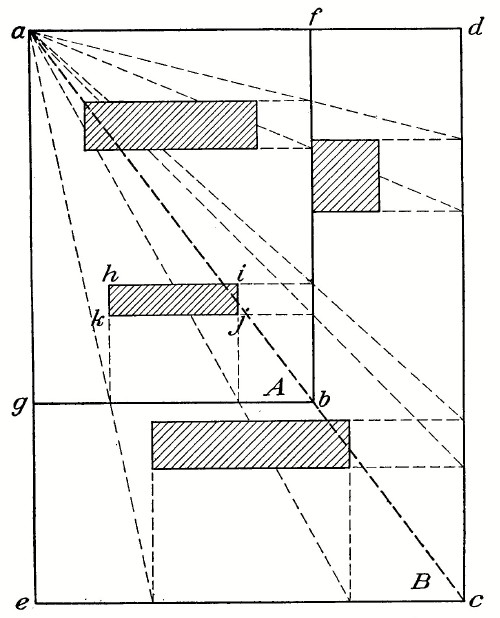| Web
and Book design,
Copyright, Kellscraft Studio 1999-2007 (Return to Web Text-ures) |
 (HOME)
|
|
CHAPTER
VIII
DRAWING FOR REPRODUCTION As the greatest amount of designed lettering done is for reproduction the student should make himself familiar with the modern graphic processes and the requirements necessary in drawing for them. Line drawings are usually reproduced by the photo-mechanical process known as zinc etching, in which the drawing is photographed on a process plate, generally with some reduction in size, the negative film reversed and printed so as to give a positive on a sensitized zinc plate (when a particularly fine result is desired a copper plate is used), which is etched with acid leaving the lines in relief, and giving, when mounted type-high on a wood base, a printing block which can be used along with type on an ordinary printing press. Wash drawings and photographs are reproduced in a similar way on copper by what is known as the half-tone process, in which the negative is made through a ruled "screen" in front of the plate, which breaks up the tints into a series of dots of varying size. Drawings for zinc etching should be made on comparatively smooth white paper (Bristol board is generally used, and tracing cloth works very successfully), in black drawing ink, and preferably larger than the required reproduction. If it is desired to preserve the hand-drawn character and quality of the original the reduction should be very slight, but if a very smooth effect is wanted the drawing may be as much as three or four times as large as the cut. The best general size is one and one-half times, linear. A reducing glass, a concave lens mounted like a reading glass, is sometimes used to aid in judging the effect of the drawing on reduction. If lines are drawn too close together the space between them will choke in the reproduction and mar the effect. As suggested on page 71 a sketch the size of the finished cut should usually be made to work from. The proportions of this sketch may be enlarged to the desired size by proportional dividers, or by making a paper scale, or by diagonals as illustrated in Fig. 120. If a diagonal ab across the original sketch afbg be extended, lines cd and ce may be drawn from any point on it, as c, and will enclose a rectangle adce of the same proportion as the original.
 FIG. 120.—Method of Enlarging a Drawing.
A line of letters, as the block hijk, may be located both for size and position by extending its sides to the edges of the original sheet and drawing lines through these points from the corner a. Where these lines intersect the edges of the enlarged sheet will give points from which the enlarged block may be located, as shown. If more than one color is to be used, for example, if some letters or parts of the ornament are to be red, these parts may be drawn with an opaque vermilion, which will photograph the same as black, or they may be drawn in black and the color indicated on the margin. The engraver will make two plates from the same negative, and will block out the colors on the zinc, giving two plates, one for the red and one for the black, of exactly the same size, and which will consequently register accurately in the printing.
One very convenient thing not permissible in other work, may be done on drawings for reproduction—any irregularities may be corrected by simply painting desired to shift a line after it has been inked it may be cut out and pasted on in the required position. The edges thus left will not trouble the engraver as they will be tooled out when the etching is finished. Often time may be saved, and in many cases effects not possible in drawing may be secured with the aid of the engraver. If a design or border is symmetrical about a center line, one-half only need be drawn and the engraver can reverse the design for the other side. |